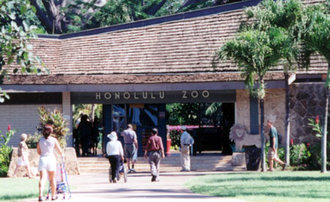Honolulu Zoo
|
|
The Honolulu Zoo is the principal zoological institution of research of Hawai'i in the City & County of Honolulu. It is the only zoo in the United States to be established by grants made by a sovereign monarch. Built on part of a 300 acre (1.2 km²) royal park in Waikiki known as Queen Kapi'olani Park, the Honolulu Zoo now features over 1,230 animals in specially designed habitats.
Over 750,000 people visit the zoo annually. The institution is administered by the Honolulu Zoo Society, a non-profit organization, and is maintained by a corps of volunteers. The zoo is owned by the City & County of Honolulu through the Auditoriums Department.
| Contents |
Queen Kapiolani Park
In 1876, the Kind David Kalakaua made royal lands near the slopes of Diamond Head available for the establishment of a grand public park for the people of his kingdom. Two hundred subscribers to the king's project formed the Kapiolani Park Association for the purpose of pursuing the mission. In 1877, the marshes, ponds and logoons in the area were beautified and it was opened as Queen Kapi'olani Park in honor of Julia Kapi'olani, Queen Consort of Hawai'i.
Even as a public park, King Kalakaua continued using the park as a place for his personal collection of exotic birds and horses. The park brought more exotic animals as it staged the Kamehameha Day celebrations and various carnivals and fairs. In 1896, the City & County of Honolulu assumed control of Queen Kapi'olani Park.
Ben Hollinger's Animals
In 1914, the City & County of Honolulu appointed Ben Hollinger to be its new Administrator of Parks and Recreation and Queen Kapi'olani Park came under his control. Hollinger maintained a fascination with animals and began collecting them to showcase at the park in Waikiki. The park became home for a monkey, a honey bear and several lion cubs. In 1916, a steamship on its way from Australia to Canada pulled into port at Honolulu Harbor. On board was an African elephant named Daisy. Hollinger pleaded with the City & County of Honolulu to purchase the elephant, which they did. With the acquisition of an elephant, Honolulu officially has a zoo. Daisy entertained visitors at the park until 1933, when Daisy was killed by Honolulu Police Department officers after trampling her trainer George Conradt.
Great Depression
During the Great Depression, the Honolulu Zoo was almost shut down for lack of finances. Even through the difficulty, it expanded its collection on November 29, 1949 with the purchase of an elephant, a Bactrian camel, sea lions, several bird species, spider monkeys and a tortoise. The Honolulu Zoo continued to operate in disrepair.
Revival of the Zoo
In 1974, the Honolulu Zoo accepted a donation of a camel, an elephant, chimpanzees and deer. These donations renewed Honolulu's enthusiasm to revive their zoo. The City & County of Honolulu approved a master plan that determined the boundaries of the present 42 acre (0.2 km²) site at the north end of Queen Kapi'olani Park. The animal collection, increased by purchase, trade and donations, was housed in newly constructed facilities, some of which still provide foundations for newer exhibits. The facility designs were influenced by the exhibits of the San Diego Zoo in California. The Honolulu Zoo experienced another revival of enthusiasm in the 1990s as the exhibits were redesigned to feature more natural settings for the animals on display.
Resources
- Honolulu Zoo (http://www.honoluluzoo.org)


